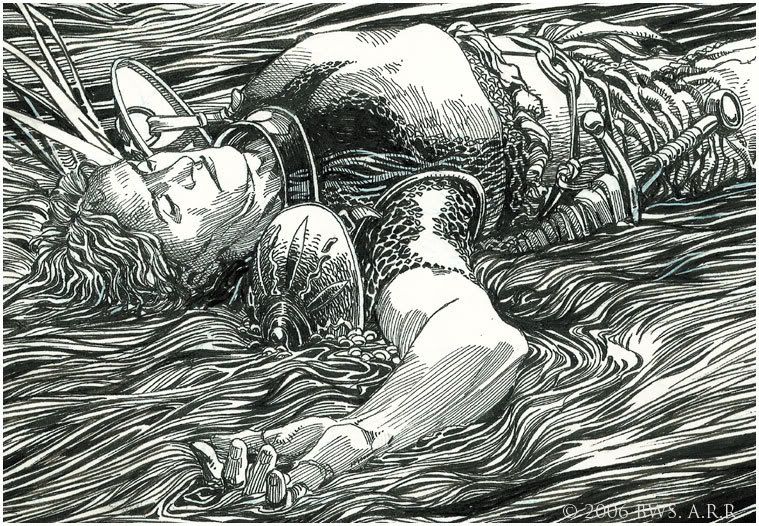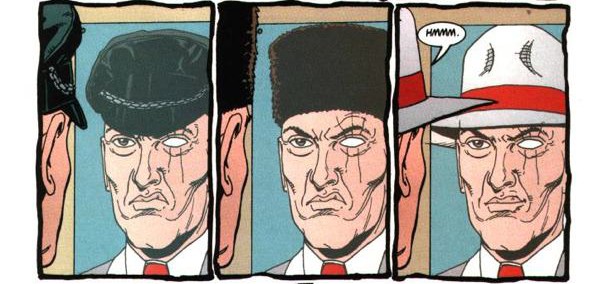 Barry Windsor-Smith began his career drawing early issues of Conan the Barbarian for Marvel comics. At that time he was creditted as Barry Smith, and legend has it that he was paid peanuts for this assignment, he accepted the assignment because he had been thrown out of his hotel, and he was working off park benches. The artist John Buscema, who followed Windsor-Smith’s 24 issue run on Conan with a mindboggling 166-issue run once said – “I know what (Barry) got paid (for Conan), and I’d be embarrassed to tell you how much it was, because I’d be embarrassed for Marvel.” But low pay notwithstanding, Barry Windsor-Smith , influenced by illustrators like Frank Frazetta (the man who drew the first popular representation of the sullen Barbarian, the long haired-muscular version that endures to this day) brought in a style and a story-telling capacity to Marvel’s adaptation of the pulp hero that would go on to define his career. He soon left Marvel comics, and went on to establish himself as a fantasy artist. He set up a commune called The Studio in the 1970s, along with fellow-artists Michael Kaluta, Jeff Jones and Bernie Wrightson, all of whom were superstar artists in their own right.
Barry Windsor-Smith began his career drawing early issues of Conan the Barbarian for Marvel comics. At that time he was creditted as Barry Smith, and legend has it that he was paid peanuts for this assignment, he accepted the assignment because he had been thrown out of his hotel, and he was working off park benches. The artist John Buscema, who followed Windsor-Smith’s 24 issue run on Conan with a mindboggling 166-issue run once said – “I know what (Barry) got paid (for Conan), and I’d be embarrassed to tell you how much it was, because I’d be embarrassed for Marvel.” But low pay notwithstanding, Barry Windsor-Smith , influenced by illustrators like Frank Frazetta (the man who drew the first popular representation of the sullen Barbarian, the long haired-muscular version that endures to this day) brought in a style and a story-telling capacity to Marvel’s adaptation of the pulp hero that would go on to define his career. He soon left Marvel comics, and went on to establish himself as a fantasy artist. He set up a commune called The Studio in the 1970s, along with fellow-artists Michael Kaluta, Jeff Jones and Bernie Wrightson, all of whom were superstar artists in their own right.
In the eighties, Barry Windsor-Smith would return to comics, writing and illustrating a Machine Man miniseries for Marvel and the acclaimed Weapon X origin story for Wolverine. (Way, way better than the limp Origin that came out much later) He also created the character Rune for Valiant comics in the 90’s, and also illustrated a couple of issues Archer and Armstrong. A stint at Dark Horse followed, with a line of original graphic novels such as Adastra in Africa and The Freebooters.
Windsor-Smith maintains a site which sells his work directly. Most of the work you will find for sale are really high-priced, even the sketches going above 500$ each. Makes a lot of sense actually, because he is a modern master.
But consider this, a recent update on his site sets a condition on people interested in buying his art. A Transfer and Sale agreement is included as a downloadable form, which the buyer must fill in and send to BWS Studios, after which he is allowed possession of the art. The terms include:
RETRANSFER: If Purchaser in any way whatsoever sells, gives, or trades the Work, if it is inherited from Purchaser, or if a third party pays compensation for its destruction, Purchaser (or the representative of his estate) must within thirty (30) days:
1. Pay Artist fifteen (15) % of the “gross art profit,” if any, on the transfer; and
2. Get the new owner to ratify this contract by signing a properly filled-out “Transfer Agreement and Record” (TAR); and
3. Deliver the signed TAR to the Artist;
4. “Gross art profit” for this contract means only: “Agreed value” on a TAR less the “agreed value” on the last prior TAR, or (if there hasn’t been a prior resale) less the agreed value in Paragraph I of this contract.
5. e. “Agreed value” to be filled in on each TAR shall be the actual sale price if the Work is sold for money or the fair market value at the time, if transferred any other way.
There are other clauses, including a Notice of Exhibition clause that makes it mandatory for the buyer to inform the artist if he’s exhibiting the work in a show, and an Artist’s Exhibition clause, by which the artist may show the work for 60 days once every five years, at a non-profit venue, and with prior notice to the buyer. The artist may also have access to photographing the work at any time, and will not allow destruction, restoration or reproduction of his work.

Needless to say, comic art collectors, quite a few of them, are peeved at caveats attached to what most people would consider a simple monetary exchange. Most of them say they would refuse to sign such a document even if the art came cheap or free, though there are some who see no problem with agreeing to all the conditions.
This makes an interesting point about conditional ownership, I thought. Especially taking into consideration the volatile, herd-driven status of the collectibles market.
Consider this case: Artist A sells one piece from comic The Amazing WhamBamPowMan to collector X for 200$. In two years, A goes on to win multiple awards with his Amazing WhamBanPowMan series, and becomes “hot”. Collector Y wants to own certain art pieces by A and finds out that X owns the piece that he wants the most. X refuses to sell him the piece. Y has got deep pockets, and X opts to go for “crazy money”, a term derisively used in comic art collecting for insanely-high amounts quoted by collectors for pieces they own, to discourage buyers from pestering them, and partly to push the envelope. (One famous instance of “crazy money” is artist Kevin Eastman’s announcement about the artwork for Teenage Mutant Ninja Turtles#1 being on sale. The asking price? One million dollars.) Coming back to our discussion, X quotes a four figure sum to Y, say, 6000$ for that single page. Y obliges. Where does that leave the artist? If he had held on to his artwork for some more time, he would have made 6000$! Taking this a bit further, Y goes on to sell to another collector for 10000$. And remember, this is not a long-term happening, it’s a 5-year, maximum 10-year time difference between all these transactions happening. All the parties concerned are still alive and kicking.
“Yes,” you might say. “But all said and done, artist A is still working. He can paint and sell his pieces at higher rates, forget the older piece. Life goes on.” The problem here is that there’s a nostalgia value attached to a certain piece of comicbook art – which is what makes every page so unique. Think about Steve Bissette/John Totleben’s run on Swamp Thing, or David Lloyd’s on V For Vendetta. Later works by these artists would not appreciate as much as a page from either of these two series would.
Personally, I think it makes quite a bit of sense for an artist, especially an artist who is so sellable, to attach such a condition on his work. Look at it this way, if a collector is buying art as a short-term investment, he will look elsewhere. Potential touts, people who lap up art by hot fringe artists to make a killing later will be discouraged, to an extent. The “crazy money” mentality might also come down a bit. All in all, I find this an encouraging step for those collectors who love the artists’ work, and who view the art as something that can be exhibited on their walls for quite some time. A recent trend has been that the “hot” artists price their original artwork rather high in the first place. For the price of an Enrique Breccia Swamp Thing piece or a John Cassaday Astonishing X-Men splash, you can actually buy quite a bit of artwork by seventies masters like Gil Kane and John Buscema. The reason for the high price, of course, is to make sure that the artist does not lose out on the money the seller will make on the piece if it’s initially priced low, and goes on to become “hot”.
Now let me just go back drool over BWS art pieces.


Quite agree about the conditional ownership thing. Even in painting, those Tyab Mehta, MF Hussein works that go at astronomical prices, often hardly any of that actually goes to the artist. So, yes, it does make a lot of sense.
And oh yeah, that artwork above is stunning, to say the least. Not that I know anything about comic book art!!
That was quite an argument you put forward. It definitely will change a few (mis)conceptions.
not so sure…
I disagree.
Why did the artist sell his work in the first place? Because he needed the money, right? If he believed in his work himself, he would have not sold it, taken a loan, and waited for it to appreciate.
Collector X, who bought it, had more faith in the artist than the artist himself, and paid his money for the art either because he liked it (signalling his superior taste), or because he believed it might be profitable in the future. I feel he, and only he, should benefit from his choice, and not the artist to the tune of 15%.
I would liken it to buying and selling of any property, share or art. And it’s not out of disrespect to any of these artists, but I’d say that this 15% is unfair.
I’m not against artists getting money for their art at all. I’m against them controlling resale and such.
Re: not so sure…
Excellent points. There has been quite a bit of debate about this going on in the comic art community that I lurk in, and quite a bit of those views mirror yours.
I would like to recommend a middle path for both the artist and the buyer. Maybe the artist would like to give a generous discount to a buyer who chooses to sign the TAR. By this, the buyer is basically saying that he is sincere in his collecting, i.e the piece won’t become a commodity for him. Even if he has to sell it, sooner or later – he wouldn’t really mind paying a bit of the profit to the artist. Being a collector, he is not really in it for the money.
The buyer who chooses not to sign the TAR can buy the piece too, but pay slightly higher asking price for the fees.
Again, this makes sense only for an artist whose credentials are already established, and whose works are seeing appreciation at an acceptable rate.
Sounds ridiculous to me. What if all collectible items were priced like this?
droolworthy